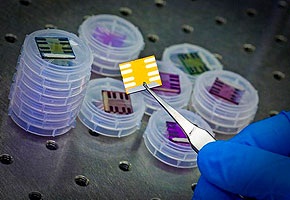SunShot offers $170 million to spur research into lowering cost of solar
 Late last Friday (April 8), the Department of Energy (DOE) announced the latest round of SunShot Initiative funding, making up to $170 million available to support research and development of lower-cost solar power solutions. The SunShot Initiative is the Obama Administration’s chief effort to reduce the cost of solar power to $1 per watt over the next decade.
Late last Friday (April 8), the Department of Energy (DOE) announced the latest round of SunShot Initiative funding, making up to $170 million available to support research and development of lower-cost solar power solutions. The SunShot Initiative is the Obama Administration’s chief effort to reduce the cost of solar power to $1 per watt over the next decade.
Previous rounds of SunShot funding were geared mainly toward specific projects, companies or institutions. This announcement is open to applicants.
“This is directed in a more broader sense, toward the people in the U.S. I think everyone should be submitting proposals,” said Ramamoorthy Ramesh, program manager for the SunShot Initiative and Solar Energy Technologies Program. “It’s addressed to a very broad spectrum.”
This round of SunShot funding covers four separate project types. Some are geared toward people in universities and labs, while others are geared toward engineers and entrepreneurs, according to Ramesh. “This is a very broad spectrum given the nature of the problem we’re dealing with; that’s what we need to do,” he said.
In this round of funding: $39 million is being made available for the Foundational Program to Advance Cell Efficiency (F-PACE); $60 million for the PV Balance of Systems program; $40 million for Solar Energy Grid Integration Systems (SEGIS)—Advanced Concepts program; and $30 million for the PV Next Generation program.
At this point the DOE has announced up to $307 million of investments for 2011 to support the SunShot Initiative. There could be more investments in 2011.
“We’re just getting into the final stages for fiscal year 2011. I guess it depends on what our financial situation looks like,” Ramesh said. “We have a lot of ideas. Clearly it depends on whether we have the financial resources to implement them.”
And Obama’s proposed budget for 2012 includes $457 million in future SunShot Initiative funding rounds.
“In the future, we may have other solicitations,” Ramesh said.
They could cover basic science to applied science or transitioning research to other phases.
“There may be solicitations that address market penetration. How do you bring in information-technology-based ideas into the solar space? These will be the back bone for future solicitations we will put out,” he said.
While the program’s ultimate goal is to reduce the cost of solar by 75 percent over the next 10 years, the DOE may reevaluate the program, based on its successes.
“If we get to 5 cents per kilowatt hour by 2016, then we’ll reevaluate it,” Ramesh said. “As long there's a key role for the government to play, we will continue to invest in it,” he said.
Once there’s not, he said the government will stop investing in solar.
Image courtesy of DOE.



